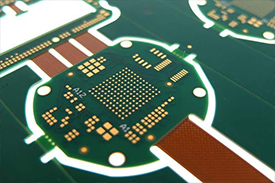Why Rigid-Flex PCBs Are Ideal for Portable Electronics
Date:2023-06-14 15:41:22
With the continuous advancement of technology, portable electronic devices play an increasingly important role in our lives. Among these devices, the rigid-flexible PCB (Printed Circuit Board, printed circuit board) has become an ideal choice. Rigid-flex PCB has unique advantages to meet the needs of portable electronic devices. This article will explore why rigid-flex PCBs are ideal for portable electronic devices and analyze their future development trends.

1. Flexibility and plasticity
The rigid-flexible PCB is composed of rigid and flexible materials, making it flexible and plastic. This design enables the PCB to adapt to devices of different shapes and sizes, resulting in a more compact and lightweight design. Portable electronic devices usually need to integrate multiple functions and components in a limited space. The rigid-flexible PCB can meet this demand, making the device thinner, lighter and more portable.
2. Anti-vibration and shock resistance
Portable electronic devices are often subject to vibrations and shocks, for example during sports or when used in vehicles. The rigid-flexible PCB can provide better anti-vibration and shock resistance, and protect the electronic components inside the device from damage. This is critical to improving the reliability and longevity of the equipment.
3. High density integration and versatility
The rigid-flexible PCB can achieve high-density component integration, enabling the device to achieve more functions in a limited space. This is especially important for portable electronic devices, as users expect more functionality in a compact device. The rigid-flexible PCB can also achieve more functions and interfaces through stacking and folding designs, providing a better user experience.
4. Save cost and improve production efficiency
Rigid-flex PCB can complete the production of the entire circuit board through one-time manufacturing. Compared with the combination of traditional rigid PCB and flexible PCB, it can save costs and improve production efficiency. This is especially important for mass production of portable electronic devices, which can reduce production costs and improve market competitiveness.
5. Future development trend
With the continuous development of portable electronic devices, rigid-flex PCB will continue to develop and innovate. In the future, we can foresee the following trends:
- Thinner and lighter design: With the advancement of technology, the rigid-flexible PCB will become thinner, making the device thinner, lighter and more portable.
- Higher integration: Rigid-flex PCB will achieve higher component integration, enabling the device to achieve more functions in a smaller space.
- Better reliability and durability: Rigid-flex PCB will further improve the anti-vibration and anti-shock performance, and protect the electronic components inside the device from damage.
- More flexible design and manufacturing technology: With the advancement of technology, the design and manufacturing technology of rigid-flex PCB will become more flexible and efficient, improving production efficiency and reducing costs.
As an ideal choice for portable electronic devices, rigid-flexible PCBs have the advantages of flexibility, plasticity, vibration and shock resistance, high-density integration and multi-functionality. In the future, with the continuous advancement of technology, rigid-flexible PCBs will continue to develop and innovate, bringing more convenience and innovation to portable electronic devices. We are looking forward to the future of rigid-flex PCB, and believe that it will play an increasingly important role in the field of portable electronic devices.
Create new value together
Tel: +86-0755-83725002
Cellphone: +86 13823764042
E-mail: sales@intechcircuit.com
24-hour service
-- Intech Electronic Group --
